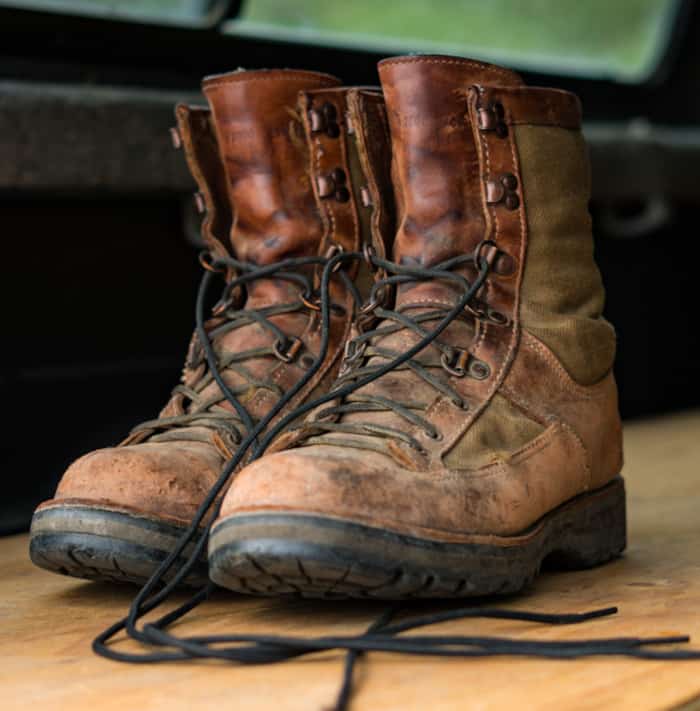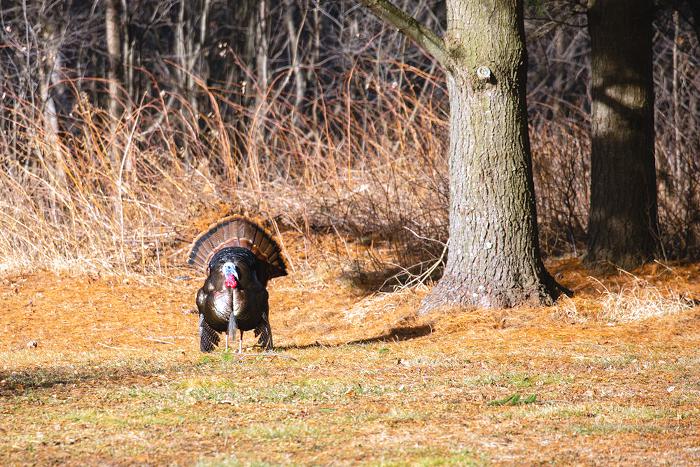If you spend enough time outdoors during the warmer months or happen to live in a warmer climate state, it’s only a matter of time before you encounter some species of snake. While most snakes found in the United States are harmless, a small percentage are known to be venomous, and those are the species that potentially cause concern for most hunters and outdoors people. In this post, we will look at venomous snakes from a hunter’s point of view and discuss the different types of snakebite protection options for hunters. This post includes an in-depth look at snake boots, snake gaiters, and snake chaps.
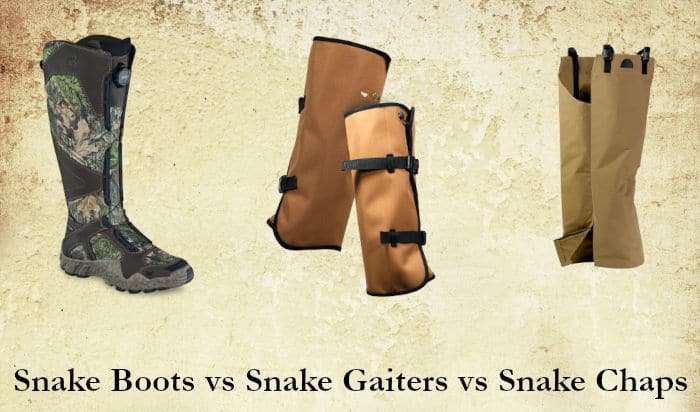
Out of the different staff members here at Hunter-Gear.com, I was selected to author this post because I have some experience with reptiles in that I’m a former reptile owner, having owned several non-venomous snake species in my youth.
Venomous Snake Facts
Before we get into details about the various snake protection gear on the market for hunters, let’s take a second and discuss venomous snakes. The United States is home to 30 known sub-species of venomous snakes that come from four species:
- Rattlesnakes
- Copperheads
- Coral Snakes
- Cottonmouth (also called a Water Moccasin)
With the exception of Hawaii, Rhode Island, and Alaska, every U.S. state is home to at least one venomous snake species. In addition, some states are home to all four venomous species, while other states may only have one of two species. My home state of North Carolina is an excellent example of a state that is home to all four venomous snake species.
The CDC estimates that between 7000 and 8000 in the United States are bitten by a venomous snake each year, and those bites result in an average of 5 deaths a year. The fatality rate for snake bites is extremely low in the U.S., thanks to the readily available top-tier medical care. Compared to some countries, the United States has an astoundingly low fatality rate. For example, India is home to 60 species of venomous snakes (including some extremely dangerous species) that kill an estimated 45,000 people annually.
In the U.S., the rattlesnake species of snakes are responsible for most of the annual snakebite deaths, but the Copperhead species owns the title of having the most instances of bites each year. The Coral species of snakes has very potent venom, but bites are incredibly uncommon as this species is shy, reclusive, and has small, fixed fangs.
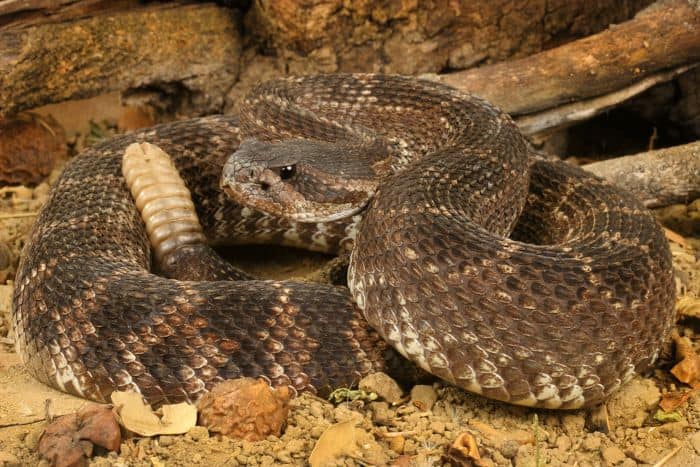
For most hunters, the species to be careful of are Rattlesnakes, Copperheads, and Cottonmouths.
Why Consider Snake Bite Protection when Hunting?
While the chances of a venomous snake bite are relatively low, it can and does happen to hunters each year. The motivation or desire to use some form of snake bite protection varies from individual to individual, but here are my reasons for wearing snake boots during warm-weather hunts:
Medical Impact
This one is somewhat obvious as I hope to avoid a venomous snake bite altogether. Statistically speaking, my odds of surviving a poisonous bite are very high, but that is only part of the equation. The CDC has reported that an average of 35% of venomous snakebite victims (especially rattlesnake bites) will have long-term medical issues that may last for years.
In addition, there are always potential complications that can become more of an issue than the bite itself, such as (and these are only a few):
- An adverse or allergic reaction to antivenin
- An allergic reaction to the venom (above and beyond its expected effects)
- Heart or brain issues (heart attack or aneurysm)
- Organ damage
I wear snake protection gear when hunting as part of an effort to avoid the potential medical issues associated with an envenomation.
Financial Impact
The financial implications are are another aspect that most people don’t consider with snake bites until it happens to them. Unfortunately, the medical costs for venomous bite victims are excessive, even with good medical insurance coverage.
Although I could not locate an average for medical costs associated with a venomous snakebite, the numbers before insurance coverage kicks in seem to be above $100,000. While this estimated figure includes all associated medical expenses with a snakebite, most of the costs are tied to antivenom.
Snake antivenom can cost anywhere from $3500 to $15,000 per dosage, depending on the specific type of antivenom, the antivenom brand, and the markup costs from the hospital.

I have a repeat customer at my place of employment share the following story about his snakebite experience and the medical bills that followed. He and I have discussed his experience in detail, and I’ve had the opportunity to gather several details of the bite experience. I’ve also seen the photographs associated with his bite, but he was not comfortable letting me include those in this post. So for the purposes of this article, we’ll call him Jack.
While feral hog hunting on a friend’s farm in northern Georgia, Jack was bitten just below the knee by a rattlesnake. He was walking down a trail and stepped over a fallen tree that was blocking the path. The rattlesnake was apparently sunning on the downed tree, and Jack had stepped almost right over him. Rather than do a warning rattle, the snake bit him and then started rattling.
He quickly moved away, and the rattlesnake slipped off the log into the thick brush. Jack called his friend, who picked him up. Given the remoteness of the location, they decided to head to the nearest hospital rather than wait for an ambulance. It was a 20-30 minute ride to the nearest medical facility, which was a smaller regional hospital.
Initially, Jack reported only moderate pain at the bite site, but it became progressively worse as the swelling spread. En route to the hospital, Jack’s knee became so swollen that he could not straighten out the leg. He reported having a strong metallic taste in his mouth and experienced a tightness in his chest. Just prior to reaching the hospital, Jack started losing control of his bowels. The bowel issue made him realize that he was in serious trouble.
When they arrived at the hospital, he was immediately admitted and assessed. Once the assessment was completed, he was administered six vials of antivenom and then received another four vials approximately 2 hours later. The antivenom used was called CroFab (I read this off the bill from the hospital pharmacy). He spent a total of 3 days in the hospital, including one night in intensive care.
Approximately 30 days later, Jack started receiving medical bills related to the treatment. Those bills totaled just over $146,000, with the 10 vials of Crofab costing $118,960 (10 X $11,896 per vial).
His insurance company covered a great deal of the costs but, initially, would only cover about $5,000 per vial of antivenom. As a result, Jack’s original out-of-pocket bills for the antivenom totaled nearly $68,000. Luckily, his total out-of-pocket costs were negotiated down to just under $9,000 out of pocket.
Additional longer-term issues:
A portion of tissue about the size of a quarter at the bite site ended up dying and had to be surgically removed and covered with a skin graft. The bite was very close to the knee, so some damage was done to the ligaments and tendons around the knee. Although Jack went through physical therapy, he still walks with a slight limp.
The point of that rather long-winded story was to highlight the ridiculously high costs that can come along with the medical treatment of snakebite. Do any internet-based research on snake bite costs, and you’ll see more of the same.
Those costs play a role in my decision to use some type of snakebite protection while hunting. Although, to be fair, in Jack’s case, only knee-high snake boots or full snake chaps would have potentially prevented the bite. Snake gaiters most likely would not have been tall enough to prevent the bite.
Types of Snake Bite Protection for Hunters
For hunters, there are three basic snake bite protection options on the market today:
- Snake Hunting Boots
- Snake Gaiters for Hunting
- Snake Proof Chaps
Let’s go each option in more detail and discuss the pros and cons of each:
Snake Hunting Boots
Snake-proof boots are a specific style of boot built to repel snake bites. This boot style typically uses a hardened nylon layer or a thick, hardened layer of leather as a barrier to snake fangs.
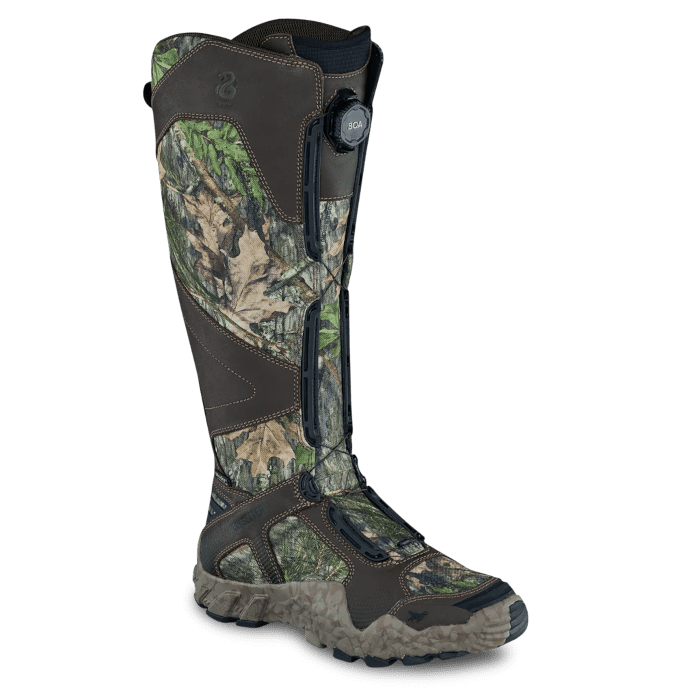
Since statistics indicate that most bites occur below the knee, snake boots are manufactured to be taller than the typical hunting boot. While most hunting boots are available in boot height ranging from 10 inches to 13 inches, snake-proof boots are available for taller boot heights ranging from 16 inches up to 20 inches. The additional height offers better protection for a potential bite occurring below the knee but above the calf area.
In addition to offering extended snake bite protection, most snake proof boot models offer similar features found on traditional hunting boots. Those features include waterproofing or water-resistant, added traction and stability, and shock absorption. Since this boot style is generally only worn during warmer weather, most snake boots are unlined and/or uninsulated.
Most popular and mainstream boot brands offer at least one or two versions of snake proof boots. Popular snake boot brands include:
- RedHead (a Bass Pro owned brand)
- Irish Setter
- Rocky
- LaCrosse
- Chippewa
- Pros & Cons
Prices for snake boots range from around $90 up to $400, depending on the brand, features, and materials.
Snake proof boots typically attach to the foot via one of three ways:
- Via Zipper
- Via Laces
- Via Snaps
While I like the zippered models for the ease and speed of taking the boots off and on, I prefer the lace-up models for the adjustability and long-term durability (zippers break all the time).
Some things to be aware of regarding snake bite proof boots:
My experience with snake boots has shown that they are more built to repel snakebites versus comfort. And, I’d say that their costs somewhat determine the comfort level of the boots as the more expensive versions seem to be more comfortable, in my opinion.
The other thing I would mention is the importance of focusing on unlined and/or uninsulated models. Snake boots are typically hot anyway, but the lined or insulated models generate much more heat compared to the unlined models.
And finally, take into account the overall weight of the boot, and consider the lightest pair that are comfortable on your feet. The heavier the boot, the more heat that they generate on your feet.
Pros
- Offers complete snake bite coverage from the foot to the top of the boot.
- Also offers protection from other objects like sticks and thorns.
Cons
- Can be hot and uncomfortable.
- The less expensive models may be less comfortable and harder on your feet.
- The lace models are more work to put on and take off compared to the zip-up models.
Snake Gaiters for Hunting
Snake gaiters, or snake bite protection gaiters, are a type of legwear that helps protect the wearer from snake bites while traveling in areas known for snakes. These types of gaiters are usually made from puncture-resistant fabric and can either be strapped around the boot or slipped over the foot.
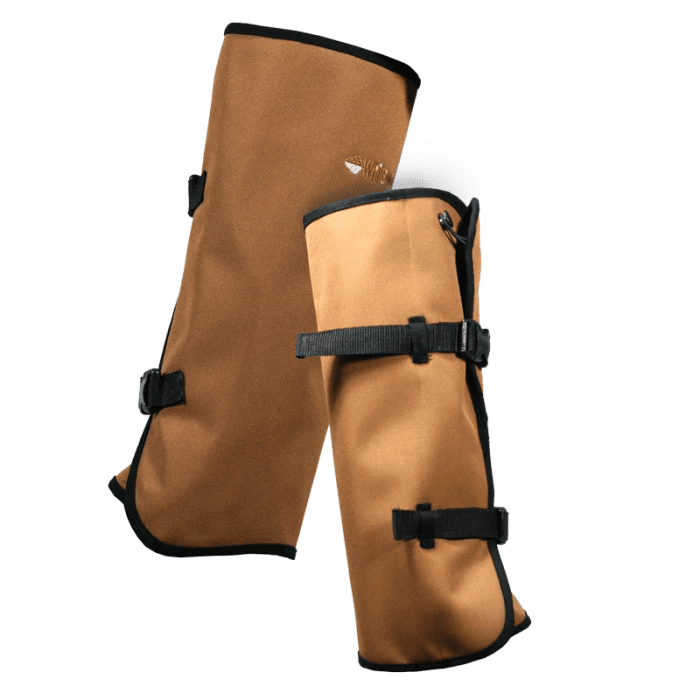
If you haven’t seen a set of snake gaiters before, they look very much like the shin protectors that soccer players wear. Gaiters are designed to be worn over the pants and boots and generally protect all the way up to the knee area.
Depending on the gaiter brand and style, some gaiters only offer protection for the front and side areas of the foot and calf but leave the rear of the calf exposed, while other gaiter models offer complete 360-degree protection around the entire leg.
Gaiters attach to the calf using different methods, including snaps, zippers, laces, or Velcro tabs. Of all the different mounting styles, I prefer the snap or laces method as I find those to be the easiest to get on and off while offering enough security to keep the gaiters in place all day.
My single biggest complaint about snake-proof gaiters is the heat that they generate while on your legs. The way they attach to your leg means they fit over your pants and compress the pants right up against your skin. Since minimal airflow can get into the pant’s legs, gaiters get warm really quick.
My one suggestion if you’re considering a pair of snake gaiters is this: steer clear of the ultra-cheap, entry-level brands as they tend to be cheaply made. I’d rather spend a little more money buying something that has some durability and will last for a few seasons. Some of the less expensive models I’ve tested over the years didn’t even make it through a single hunting season without a strap or buckle breaking or the stitching coming undone.
I’m not saying you need to blow your budget out of the water, but I would lean towards the mid to higher-priced units versus the bottom end of the pricing scale.
Some of the more popular snake gaiter brands on the market are:
- Turtleskin (Expensive but very nice)
- Crackshot Corp
- Razer
Pros
- A very lightweight option compared to snake boots or snake chaps.
- Can be the least expensive option for snake protection.
- Allows the user to wear their favorite pair of hunting boots into the woods.
- Reasonably easy to put on and take off.
Cons
- Gaiters heat up quickly and can make your calves and ankles sweat profusely.
- They do not offer the level of snake bite coverage compared to boots, as gaiters always have a certain amount of the boot exposed. If the boots underneath the gaiters won’t repel a snake bite, there’s more risk than snake boots.
- Some budget brands appear to be cheaply made and may not be all that durable.
Snake Proof Chaps
Snake proof chaps are also called snake-proof pants, even though the chaps are not considered pants in the traditional sense. This style of chaps is basically snake-proof legging garments that cover the leg from the boot all the way up to the hip area.
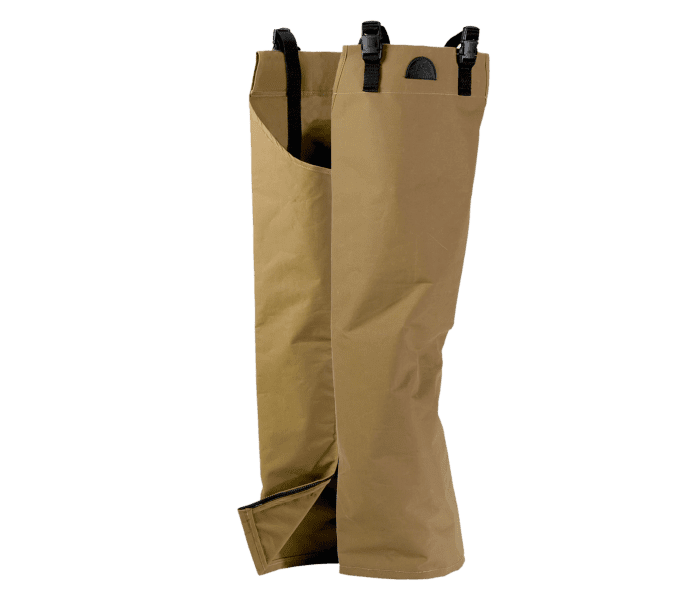
Chaps are similar to gaiters, except that chap cover almost the entire leg. Chaps typically come in a set with one chap for each leg. Snake chaps are worn over the pants, and most models attach to each side of a belt.
While chaps offer more protection coverage than gaiters, most chaps don’t completely cover the boot area. Another thing to know about chaps is they can get extremely hot. As a matter of fact, between snake boots, snake gaiters, and snake chaps, the chaps are absolutely the hottest option of the three.
One summer, I was asked to help out a neighbor, who yard had become overgrown and was full of fallen limbs, brush piles, and trash. It looked extremely “snaky,” so I opted to do the work in snake chaps as they offered the most protection coverage over my body. Well, the combination of the physical activity and the heat generated from the chaps nearly caused me to have a heat stroke. In addition, I had worn blue jeans under the chaps, and the jeans were absolutely soaked in sweat from being covered by the chaps.
Pros
- Offers better overall coverage compared to boots or gaiters.
- Easier to put on or take off compared to boots but harder than gaiters.
Cons
- Easily the hottest option from a heat standpoint of all three options.
- Most chaps do not cover the entire boot, so there is a potential vulnerability at the lower boot level.
Comparing the 3 Options
Let’s compare each of the snake bite protection options head-to-head as some are better suited for certain situations than others.

Snake boots vs Snake Gaiters
Both of these examples of snakebite protection gear have their place and are valid options for hunting in venomous snake country.
Gaiters are lighter, less expensive, less hot, and easier to put on and take off compared to snake boots but don’t offer the same amount of bite protection that boots provide. In addition, gaiters almost always leave the lower part of the boot exposed, and some even leave the back of the calf exposed. However, gaiters also work with a favorite or preferred pair of hunting boots or hiking boots.
Snake boots offer the features of a boot (traction, ankle support, etc.) and provide more bite protection than gaiters. Boots are not typically as warm as gaiters, but the specific boot style, model, and type may play a role in the heat retention. Boots almost always cost more than gaiters, but a top-quality set of gaiters isn’t cheap either.
Snake Chaps vs Snake Boots
Snake chaps offer more bite coverage than boots but are a hotter option as they generate and retain more heat than boots. Chaps are easier to get on and off compared to boots, but the cost of a good set of chaps can be very close to the costs of a good pair of snake boots.
Chaps also work well for walking through areas with thorns or briars and perform better than boots in that capacity.
Snake Gaiters vs Snake Chaps
Similar to snake boots, snake chaps offer more protective coverage on the body than snake gaiters. However, gaiters are less bulky, weigh less, cost less, and retain less heat than chaps. Gaiters are easier to put on or take off, compared to chaps as well.
Snake chaps offer more protective coverage than gaiters, but weigh more, cost more, and are significantly hotter than gaiters.
What’s the Best Snake Proof Option for Hunters
First, a quick disclaimer: snakebite protection products are not foolproof, and there is always a risk that you could still sustain a bite in a venomous snake encounter.

The best option will be more of a personal decision based on budget, needs, amount of desired protection, and comfort.
If you’re in the market for some kind of snake bite protection gear, I’d say the following:
- If you are strictly shopping on a budget only, then snake gaiters will be the least expensive option. However, as I previously mentioned, the really low-cost models may be cheaply made and not last very long before breaking or failing.
- If you already have a favorite pair of comfortable boots that you like but want some kind of additional snake protection, then chaps or gaiters are your best option, as either can be worn over your existing hunting boots.
- If you only need snake protection a few times a year, then gaiters are probably going to be your best option due to the lower costs and ease of use.
- If you spend a significant amount of time hunting in snake country, then I’d consider investing a bit of money in either a good set of comfortable snake boots or a good set of snake chaps.
- If you are interested in having the largest amount of your body protected, then chaps are going to be your best option.
- If cost is not a major factor and your budget is wide open, I’d consider investing in a high-end pair of snake boots as they are the coolest of the three options and offer the best coverage for the area of your body statistically most likely to be bitten.
Personally, I prefer snake boots, and you won’t catch me without them when hunting during the warmer months or when venturing into the woods during snake bite season.
FAQS
Can a snake bite through rubber boots?
The answer to that question will depend on several factors, including:
- Brand of boot
- Thickness of rubber used in the boot
- Size of snake
- Species of snake (some have longer fangs than others)
Although there are many variables to consider, the short answer is yes, a venomous snake can potentially bite through a basic run-of-the-mill rubber boot. The odds of penetrating a rubber boot increases with the size of the snake. For example, a large Diamondback Rattlesnake can have fangs nearly an inch long when deployed during a strike. However, it’s difficult to say if the fang length is long enough to make skin contact. But basic rubber boots might be enough to stop a bite from a juvenile Copperhead with smaller-length fangs.
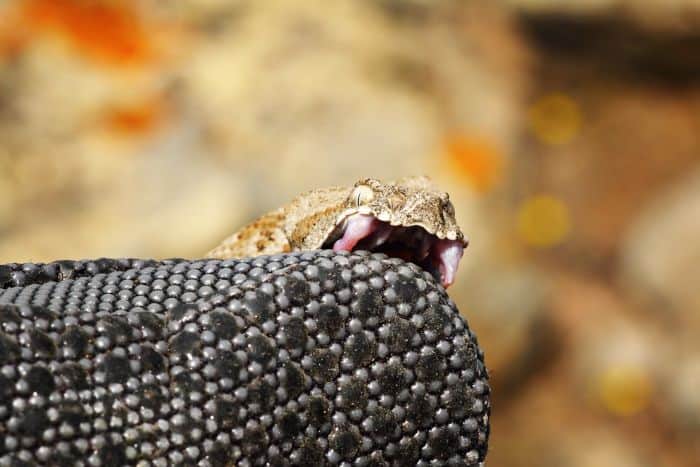
However, rubber snake boots are a bit different as they are built with enough thickness or have a protective insert to repel bites from most all venomous snakes found in the United States.
Rubber hunting boots are very popular in the U.S. because they are waterproof and lightweight. If you’re in the market for a rubber-based hunting boot and you want something with snakebite protection, I’d suggest buying rubber snake boots that are specifically marked as being made or marked as snake bite-resistant.
Popular brands that offer rubber snake boot models are:
- LaCrosse
- Rocky
- Original Muck Boot Company
- Thorogood
- Irish Setter
Do snake boots really work?
Although I’ve been fortunate enough so far to have avoided testing any snake bite products firsthand, I’ve seen enough videos, spoken to enough vendors in the boot industry, and observed sufficient live demos, to say that snake boots really do work in stopping venomous snake bites.
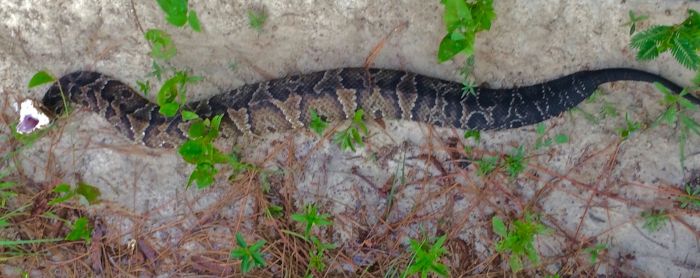
It’s essential to understand a few aspects of snake bites that tie into the question:
Snake boots don’t stop a bite from happening; they just provide a sufficient barrier so the bite can’t make contact with your skin.
Snake boot claims of being bite-proof are more geared towards venomous snake species found in North America (Predominately the United States). However, some venomous snake species found on other continents like Africa and India have species with longer fangs. The best example of that is the Gaboon Viper, which has fangs that can be over two inches long. Unfortunately, most commercially produced snake boots in the U.S. are not designed to withstand fangs that long.
Can a snake bite through leather boots?
Assuming that we are focusing on basic leather boots, the answer to that question will depend on several factors, such as:
- Type of leather boot (hunting boot, dress boot, cowboy boot, etc.)
- Thickness of the leather
- Brand of boot
- Leather condition
- Size and fang length of the snake
There are too many variables to provide a universally definitive answer that will cover all possible scenarios. For example, with worn leather boots or models with thin leather, it is possible that a larger venomous snake species with longer fangs could potentially penetrate a basic leather boot.
Although they were not explicitly made or advertised as being snake-proof, most cowboy boots on the market seem to be able to repel most snake bites.
With hunting boots that are not explicitly designed to be snake bite-proof, the answer will depend on the factors listed above.
My advice would be to assume that leather boots can be penetrated by a snake bite and proceed accordingly.
Do snake gaiters work?
My experience has been that snake gaiters do work in protecting the area covered from a snake bite. However, as note above, snake gaiters do not cover the entire boot, and some styles do not cover the rear of the calf.
I’d suggest staying away from extremely budget-priced models as they tend to be cheaply made and don’t seem to last very long.
Do snake chaps work?
Snake chaps are an effective method of protecting the legs from snake bites. They also work well to protect the legs from thorns, briars, and other pointed underbrush.
As mentioned before, note that most chap styles do not cover the entire boot, so there may be an unprotected area of the boot.
What are snake chaps made of?
Snake chaps are manufactured from several materials, including denier nylon (probably the most popular material), Kevlar, synthetic weaves like ballistic nylon, and leather.
Leather is the least common material used in snake chaps today, as the more modern weave materials are lighter and significantly less expensive to use compared to leather.
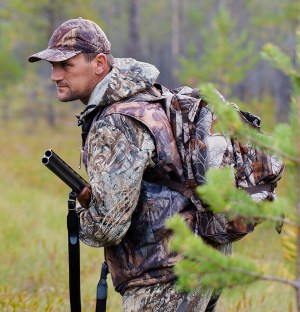
Born and raised in the North Carolina foothills, Andy was introduced to the outdoors at a very young age. Like most beginning hunters, he started out hunting small game like rabbits and squirrels, then graduated to larger species like Whitetail Deer. Although he’s an avid deer and turkey hunter, he still enjoys hunting small game as well. Andy has worked in the hunting and fishing industry for nearly 25 years.




